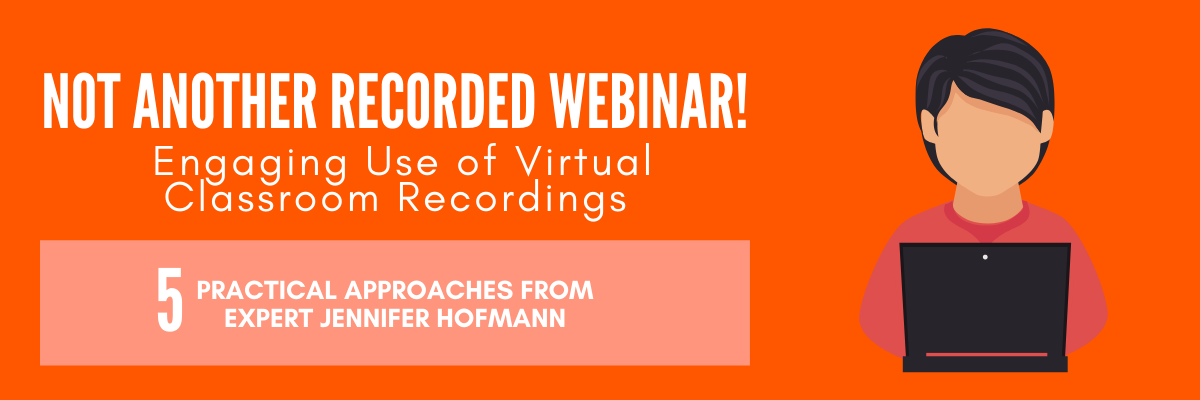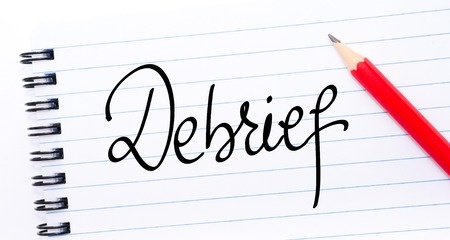Video - Donna Designer Shares Gamification and Game-Based Learning
Gamification and game-based learning have become commonplace in modern learning instructional design. The flexibility and adaptability of...
4 min read
 Jennifer Hofmann
:
Nov 5, 2019 8:00:00 AM
Jennifer Hofmann
:
Nov 5, 2019 8:00:00 AM


When should we record live virtual classroom sessions, and how can we design quality, engaging recordings for on-demand audiences?
I’ve never been fond of recording all virtual classes and making them available on demand. I’ve always felt that devalues live virtual instruction. After all, if there is no difference in the learner experience for someone to attend a live program versus a recording, then why deliver any live content?
Nevertheless, whether it’s an information-dense webinar or a hands-on, collaborative virtual lesson, most organizations have thousands of hours of recorded sessions in their training libraries.
People watch five billion videos a day just on YouTube! This crazy number doesn't even include other video platforms and recorded webinars.
Twenty percent of people who start a YouTube video will leave after the first 10 seconds!
Research suggests that six minutes is the optimal length for instructional videos. After six minutes engagement drops rapidly. In fact, another study showed that most learners won’t watch video training for more than 15 minutes.
Considering how dependent we seem to have become on recordings, these statistics are depressing. I think that the first 10 seconds of a YouTube video are usually more engaging than the first five minutes of a recorded webinar, where the host is often trying to help people just connect to the audio.
And if six minutes is the optimal length for instructional videos, how much are our learners really getting out of one or two hours of recorded lecture?
If you’re like me, you’ve got an entire folder full of links to webinar recordings that you intend to watch one day. The topics were on point, the speakers might be people you respected in the field, or for some other reason the topic sparked your interest.
Maybe it was even required.
But having good intentions doesn’t add more hours to our day. And having good intentions doesn’t remind us that those recordings are sitting there just waiting for us to watch them.
So should we make recorded virtual sessions available at all?
There are some great reasons to make recordings of live sessions available. Recordings can:
Sometimes learners just need to go back and review, either the next day or the next week or the next year. If an individual already has foundational knowledge about the content, a recording can provide clarification or a good review.
The best learning environments consist of very diverse audiences. They bring together people with varying levels of expertise, from different generations and cultures, and with different perspectives. This diversity can make the conversation very rich, but also can create challenges for individuals where the delivery language isn’t native or who have other individual needs. Knowing that classes are available for review after the fact can help to foster environmental engagement and enrich the learning experience for everyone.
I don't think there's any better way for a facilitator to prep to teach new content than to be able to observe a well-delivered program via recording while following along with the facilitator guide. They can observe interactions, customize their own personal stories, and identify topics on which they might need additional coaching. This opportunity is something that wasn’t easily available in more traditional training environments.
Recorded events are a great way for instructional designers and stakeholders to evaluate pilots and determine what changes need to be made to new content and provide a way to reconcile learner feedback with the actual delivery.
The observer effect is the theory that the mere observation of a phenomenon inevitably changes that phenomenon. We all sit up straighter during a job interview than we do at our desks. When evaluating facilitators, watching a recording can provide more realistic data about how effective a facilitator is at managing environmental, intellectual, and emotional engagement in the virtual classroom.
We know research tells us that viewers can check out very quickly when watching a recording, and most people won’t watch video training for more than 15 minutes.
If the intention for a session is that most people will watch the recording, then that content should be designed for the on-demand audience. Don’t publicize the event for a general audience. Rather, design short, on-topic webinars that quickly engage viewers and point them to resources where they can learn more.
Designing a session that’s going to be seen mostly or exclusively via playback is very different than the design of a live session. Here is our approach to designing this type of on-demand learning in an engaging format:
Don’t spend that valuable first 10 seconds introducing yourself or covering housekeeping tips. Create a “hook” that immediately intellectually engages the viewer in the content.
Make it very clear what you intend to accomplish during this recording. Keep information short and to the point. And let them know they’ll have the ability to download additional tools and information at the end.
This is the one time I would caution against trying to engage your audience with interactive activities. They are usually not fun to watch in a recording.
Invite members of your team to attend this recording, and provide them with scripted comments and questions to be asked aloud or via chat. The facilitator should be ready with scripted responses to these comments and questions. Including these multiple voices makes the program more engaging and memorable.
Instead of attempting to include every bit of information about a topic in a recording, keep the message concise and high level, and encourage the use of supporting microlearning assets to fill in the blanks. People aren’t going to remember 60-minutes’ worth of content – but they will appreciate having a toolkit to take home with them.
Recorded webinar content is a relatively inexpensive way to provide on-demand training content. However, it should be designed purposefully with the on-demand audience in mind.
So, the next time you hit that “record” button, think about how that recording is going to be used.

Gamification and game-based learning have become commonplace in modern learning instructional design. The flexibility and adaptability of...

1 min read
We’ve been using virtual classroom technologies for more than 20 years now. Unfortunately, we are still holding on to a content model that insists...

We're excited to have Oded Ilan, Chief Marketing Officer of Iridize, join our Guest BYTE speaker list on January 31. In support of his live learning...